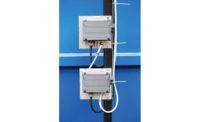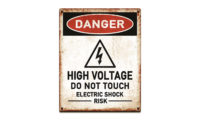NFPA® 70E-2018 standard for electrical safety requirements

Scope
The National Fire Protection Association® 70E® standard covers most workplace activities related to electrical energy or equipment. The 2018 edition continues to focus on risk assessment and introduces human factors, such as human error, as part of the assessment. Emphasis is now placed on the hierarchy of risk controls methods: 1) Elimination; 2) Substitution; 3) Engineering controls; 4) Awareness; 5) PPE.
Major exceptions are vehicles, such as ships, aircraft, and railway rolling stock; railway electrical systems used exclusively for the operation of rolling stock or installations, or used exclusively for signaling and communications; communications equipment, under the exclusive control of communications utilities, and located outdoors or in buildings used exclusively for such installations; and certain electrical installations under the exclusive control of an electric utility.
Why this standard is important
NFPA 70E responds to the latest information about the effects of arc flash, arc blast, and direct current (dc) hazards, and recent developments in electrical design and personal protective equipment (PPE). It provides vital information that helps you comply with OSHA 1910 Subpart S and OSHA 1926 Subpart K.
If you're responsible for ensuring workers are protected from shock and arc flash hazards, use the 2018 edition of NFPA 70E along with NFPA 70®: National Electrical Code® (NEC®) and NFPA 70B: Electrical Equipment Maintenance.
Article 110 of NFPA 70E identifies the general requirements for electrical safety-related work practices. One major requirement is performing a risk assessment before any work is started to identify the process to be used by the employee to identify hazards, assess risks and implement risk control according to the hierarchy of risk control methods. The procedure must address the potential for human error and its negative consequences on people, processes, the work environment and equipment.
These assessments must identify the hazards, estimate the likelihood of the occurrence and potential severity of injury or damage to health and determine if additional protective measures are required, including the use of personal protective equipment (PPE).
The electrical safety program must include elements to investigate electrical incidents.
Key requirements
Far too many to list in detail here. Purchase NFPA 70E® at www.nfpa.org. NFPA 70E defines work practices that protect workers from electrical hazards, including arc flash hazards, during the inspection, operation, and maintenance of electrical equipment. NFPA 70E also specifies safe work practices for employees who may not be directly working on electrical equipment, but who are performing work that might expose them to electrical hazards.
Article 110 also addresses the potential for human error and its negative consequences on people, processes, the work environment and equipment; and Job Safety Planning and Job Briefing.
Article 120 requires employers to establish, document, and implement a lockout/tagout program and specify lockout/tagout procedures to safeguard workers from exposure to electrical hazards.
Article 130 of the standard specifically addresses work involving electrical hazards and covers any work condition that requires an electrically safe work condition; and any work involving safety-related work practices, assessments, precautions, and procedures when an electrically safe work condition cannot be established. To quantify the risk present in the covered work, NFPA 70E-2018 identifies two assessments that must be done for each affected electrical equipment piece: Shock Risk Assessment and Arc Flash Risk Assessment. They must identify the hazard, estimate the likelihood of occurrence of injury or damage to health and the potential severity of injury or damage to health; and determine if additional protective measures are required, including the use of PPE.
If likelihood does exist (designated as a yes response in the table) appropriate arc flash PPE must be determined by one of two methods: Incident energy analysis method or Arc flash PPE category method. One or the other method must be used, but not both on the same piece of electrical equipment.
Keywords
Qualified Person: NFPA 70E defines a qualified person as someone who has the skills and knowledge to work on electrical equipment, and who has received the training to identify and avoid the associated hazards. An unqualified person does not have these skills, knowledge, or training. Because different equipment may pose different hazards, and different tasks may require different skills, it's possible for a given worker to be "qualified" for one job and "unqualified" for another.
Labels: NFPA 70E requires equipment owners to apply detailed and informative labels to any electrical equipment that is likely to require adjustment or maintenance while energized. Labels must include nominal system voltage; arc flash boundary; at least one of the following: 1) the available incident energy and corresponding working distance, or 2) the arc flash PPE category for the equipment as listed in tables in the standard, but not both; minimum arc rating of clothing; and site-specific level of PPE.
Training: There is no single requirement for workers to be trained on the entire NFPA 70E standard. Instead, a recurring theme in the standard is that workers need to have specific training for the tasks they will perform.
If a task involves electrical hazards, only a qualified person should be allowed to do that work. To be qualified, the worker needs specific training that will allow him to perform the work safely. That training will include recognition of hazards, appropriate work procedures, and the proper use of protective equipment (including lockout/tagout equipment as well as PPE).
Does OSHA require compliance with NFPA 70E?
In specific terms, no. NFPA 70E is a national consensus safety standard published by NFPA primarily to assist OSHA in preparing electrical safety standards. Federal OSHA has not incorporated it into the CFRs. But OSHA often refers to accepted industrial practices for certain work, and NFPA 70E is a widely-accepted and respected standard for safe electrical work practices. If OSHA determines that compliance with the 70E electrical safety standard would have prevented or lessened the injury, OSHA may cite the employer under the General Duty Clause. In a 2003 standards interpretation letter, OSHA stated the 70E electrical safety standard can be used as evidence of whether the employer acted reasonably.
History
Originally developed at OSHA's request, the first edition of NFPA 70E was published in 1979 and contained installation safety requirements borrowed from the National Electric Code. In 1981, safety-related work practice requirements were added. In 1995, “limits of approach” and “arc flash” concepts were introduced. Throughout the 1990s and 2000s the emphasis was on arc flash PPE requirements. With the 2015 edition, the focus began to shift from PPE requirements to the employer’s duty to create a comprehensive electrical safety program and integrating it into their occupational health and safety management system.
Looking for a reprint of this article?
From high-res PDFs to custom plaques, order your copy today!





